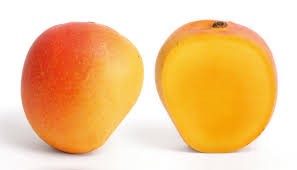Mango
Scientific Name: Mangifera indica
Climate: Hot
Plant Description: The mango tree grows between 10 and 30 meters tall with a rounded crown. It is evergreen and has strong roots. The sap can be irritating to the skin. The leaves are long, oval-shaped with pointed tips, and have an intense red color when they are young, turning dark green as they mature. It is cross-pollinated by insects. The fruit is a stone fruit, meaning it has a large, hard pit and is surrounded by flesh. The fruits have a variety of colors, sizes, and shapes, and often change colors as they mature.1
The mango is native to South Asia, from where it has been distributed worldwide to become one of the most cultivated fruits in the tropics.
Cultivation: Reproduction by seed is possible, but the plants are inferior to the parent and do not retain their characteristics. To plant the seed, the pod must be removed. The best way to do this is to cut the edges of the husk. Once the seed is free, it is planted in pots measuring 20 to 25 cm deep and 18 to 20 cm in diameter. The soil should be light and you should try to mix it with peat or soil with plenty of organic material. The seed should be planted 2.5 to 3.5 cm deep. Within the first 20 days the seeds will germinate.
The tree is a little difficult to graft; the best results have been given by proximity or shield grafts. Seeds planted in June and July can be grafted between November and January, and be ready to be planted in the field from July to August of the following year.
The best time for bud grafting is from mid-spring and summer, when the plants are in active growth. When the seed trees have reached the diameter of a pencil they can be grafted, although it is advisable to let them grow a little longer.
The buds to be grafted should be taken from the tips of the young branches, but not from those of the last growth. It is important that the segment to be grafted and the rootstock are the same or similar in size and maturity of the wood. If possible, twigs should be chosen from which the leaves have fallen. In any case, the grafting wood should be well matured and the tip of the twig from which it is taken should not be in active growth.
Grafted plants start producing fruit after three or four years (10-20 fruits), giving the optimum crop after 10-15 years which continues to increase until 40 years under good management. The fruit takes 100-120 days, generally speaking, from blossom to harvest.
It can grow well in a range of soils as long as they are deep and well drained. It should be planted in direct sunlight. Young plants are watered frequently. In the case of mature trees, watering at 10 to 15 day intervals from fruit to maturity is beneficial for improving the crop. However, irrigation is not recommended for two or three months before flowering, as it is likely to promote vegetative growth at the expense of flowering.
 Uses: Its fruit is edible and can be preserved very well. Good for the skin, stimulating the immune system, the eyes and the heart, and improves digestion, and is good for the skin and for diabetes. It can help prevent osteoporosis and muscle cramping, helps to control blood pressure and good kidney function. The fruit is slightly acidic.2
Uses: Its fruit is edible and can be preserved very well. Good for the skin, stimulating the immune system, the eyes and the heart, and improves digestion, and is good for the skin and for diabetes. It can help prevent osteoporosis and muscle cramping, helps to control blood pressure and good kidney function. The fruit is slightly acidic.2
Pests and Diseases: The most serious mango disease is anthracnose, a fungus that can cause the flowers to turn black and fall off. It also causes black spots on the stem and small fruit and the leaves may turn brown. To prevent this fungus it is important to separate the trees, remove weeds, ensure good drainage and avoid monoculture. It can be fumigated with a mixture of four liters of water with a tablespoon of baking soda and 2.5 tablespoons of vegetable oil. Whisk and add half a teaspoon of natural soap. It is applied every week until the symptoms disappear.3
References:
- http://www.platicar.go.cr/images/buscador/documents/pdf/01/00471-mango.pdf
- https://www.cuerpomente.com/guia-alimentos/mango
- http://archivo.infojardin.com/tema/receta-de-tratamiento-natural-contra-antracnosis-tizon-mildiu-oidio.379586/
En español: Mango

